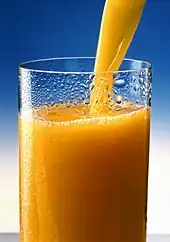
Overview

Carrot juice has a particularly high content of β-carotene, a source of vitamin A, but it is also high in B complex vitamins like folate, and many minerals including calcium, copper, magnesium, potassium, phosphorus, and iron. A pound (454 g) of carrots will yield about a cup of juice (about 236 ml), which is a low yield compared to fruits like apples and oranges. However, carrot pulp is very tough; the main difficulty in juicing carrots is in separating the pulp from the juice.
Like many products high in beta-carotene, it may cause temporary carotenoderma, a benign skin condition resulting in an orange-yellow hue to the skin.[1] Drinking more than 3 cups of carrot juice in a 24-hour period over a prolonged period of time may be enough to cause the condition.[2]
Carrot juice has a uniquely sweet flavour of concentrated carrots. Unlike many juices, it is opaque. It is often consumed as a health drink. Carrots have been made into soups and juices for hundreds of years. In America carrot juice was one of the first colorants used to make cheese a darker color.
Nutritional information
100 g of canned carrot juice contains the following nutritional information according to the United States Department of Agriculture (USDA):[3]
- Calories : 40 kcal
- Protein: 0.95 g
- Fat: 0.15 g
- Carbohydrates: 9.28 g
- Dietary fibers: 0.8 g
- Cholesterol: 0 mg (insignificant amount)
See also
References
- ↑ Kristin Mortensen. "Toxicity of Carrot Juice". Livestrong.com. Retrieved 5 May 2015.
- ↑ eMedicine – Carotenemia : Article by Robert A Schwartz
- ↑ "FoodData Central". fdc.nal.usda.gov. 2019-04-01. Retrieved 21 February 2021.
